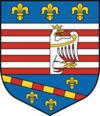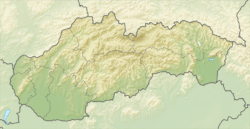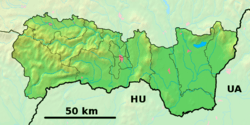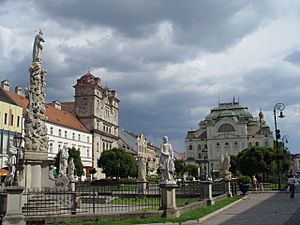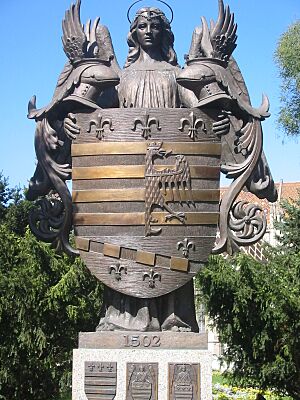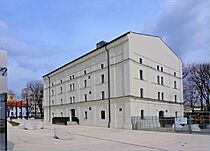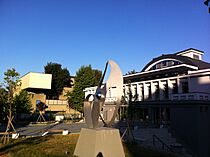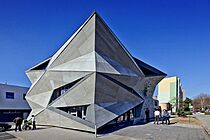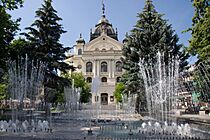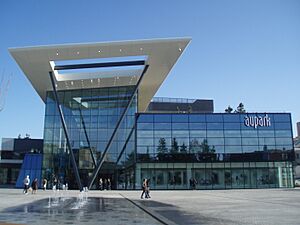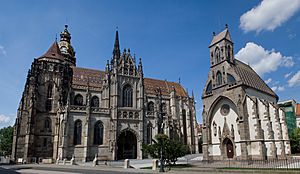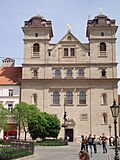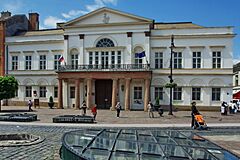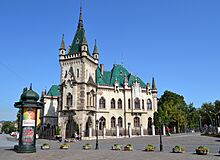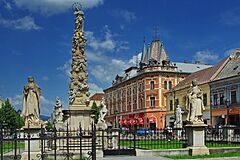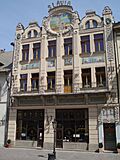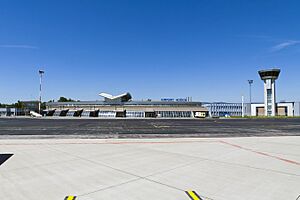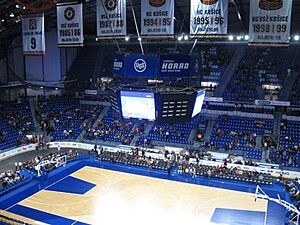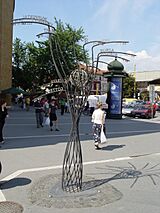Košice facts for kids
Quick facts for kids
Košice
|
|||||
|---|---|---|---|---|---|
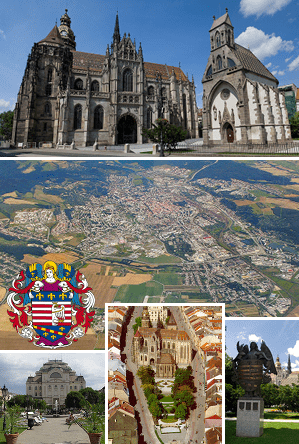
Top: Cathedral of St. Elizabeth and St Michael Chapel
Center: general aerial view Bottom (left to right): State Theater; Center of Hlavná street; Coat of Arms Statue Superimposed: coat of arms |
|||||
|
|||||
| Nickname(s):
City of Tolerance
|
|||||
| Country | |||||
| Region | Košice Self-governing Region | ||||
| District | Košice I, Košice II, Košice III, Košice IV | ||||
| First mentioned | 1230 | ||||
| Area | |||||
| • City | 243.7 km2 (94.1 sq mi) | ||||
| Elevation | 206 m (676 ft) | ||||
| Population
(2021-07-01)
|
|||||
| • City | 228,249 | ||||
| • Density | 936.60/km2 (2,425.8/sq mi) | ||||
| • Metro | 368,725 | ||||
| Time zone | UTC+1 (CET) | ||||
| • Summer (DST) | UTC+2 (CEST) | ||||
| Postal code |
040 00
|
||||
| Area code(s) | +421-55 | ||||
| Car plate | KE | ||||
| GDP | 2017 | ||||
| – Total | Nominal: €18 billion PPP: $21 billion |
||||
| – Per capita | Nominal: €18,100 PPP: $16,300 |
||||
| Website | https://www.kosice.sk | ||||
Košice is the biggest city in eastern Slovakia. It sits on the Hornád River, close to the border with Hungary. With about 230,000 people, Košice is the second-largest city in Slovakia. Only the capital, Bratislava, is bigger.
Košice is a major center for business and culture in eastern Slovakia. It is home to the Slovak Constitutional Court and three universities. You can also find many museums, art galleries, and theaters here. In 2013, Košice was named a European Capital of Culture, sharing the title with Marseille, France. The city is also an important industrial hub. The U.S. Steel Košice factory is the largest employer. Košice has great train connections and an international airport.
The city has a beautiful old town center. It is the largest historical center in any Slovak city. Many buildings are protected as heritage sites. They show different styles like Gothic, Renaissance, Baroque, and Art Nouveau. The Cathedral of St. Elizabeth is Slovakia's largest church. The main street is long and full of old palaces, churches, and houses. It is a lively area with shops, cafes, and restaurants. Košice was the first city in Europe to be given its own coat of arms.
Contents
- What Does the Name Košice Mean?
- A Look at Košice's Past
- Where is Košice Located?
- What is the Weather Like in Košice?
- Who Lives in Košice?
- Culture and Arts in Košice
- Košice's Economy
- What to See in Košice
- Learning in Košice: Universities and Schools
- Getting Around Košice
- Sports in Košice
- Košice's Twin Cities
- Images for kids
- See also
What Does the Name Košice Mean?
The city was first written about in 1230 as "Villa Cassa." The name probably comes from an old Slavic name, Koš or Koša. This would mean "Koš's people" or "Koš's place." Similar names are found in other Slavic countries.
Another idea is that the name comes from the Old Slovak word kosa, meaning "clearing." This is related to the modern Slovak word kosiť, which means "to reap" or "to cut grass." Some sources also suggest the name might come from an old Hungarian first name starting with "Ko."
Over time, the city has been known by many names in different languages. For example, it was called Kaschau in German and Kassa in Hungarian.
How the City's Name Changed Over Time
Here is a timeline of how the city's name has changed:
| Year | Name | Year | Name |
|---|---|---|---|
| 1230 | Villa Cassa | 1420 | Caschowia |
| 1257 | Cassa | 1441 | Cassovia, Kassa, Kaschau, Košice |
| 1261 | Cassa, Cassa-Superior | 1613–1684 | Cassovia, Kassa, Kaşa, Kossicze |
| 1282 | Kossa | 1773 | Cassovia, Kassa, Kaschau, Kossicze |
| 1300 | Cossa | 1786 | Cassovia, Kascha, Kaschau, Kossice |
| 1307 | Cascha | 1808 | Cassovia, Kaschau, Kassa, Kossice |
| 1324 | Casschaw | 1863–1913 | Kassa |
| 1342 | Kassa | 1918–1938 | Košice |
| 1388 | Cassa-Cassouia | 1938–1945 | Kassa |
| 1394 | Cassow | 1945– | Košice |
A Look at Košice's Past
![]() Kingdom of Hungary 1000 – 1526
Kingdom of Hungary 1000 – 1526
![]() John Zápolya's Eastern Hungarian Kingdom 1526 – 1551
John Zápolya's Eastern Hungarian Kingdom 1526 – 1551
![]() Hajduk rebels of István Bocskai 1604 – 1606
Hajduk rebels of István Bocskai 1604 – 1606
![]() Principality of Transylvania 1619 – 1629, 1644 – 1648
Principality of Transylvania 1619 – 1629, 1644 – 1648
![]() Kuruc rebellion 1672 – 1682
Kuruc rebellion 1672 – 1682
![]() Imre Thököly's Principality of Upper Hungary 1682 – 1686
Imre Thököly's Principality of Upper Hungary 1682 – 1686
![]() Francis II Rákóczi's insurrection 1703 – 1711
Francis II Rákóczi's insurrection 1703 – 1711
![]() Kingdom of Hungary 1804 – 1867
Kingdom of Hungary 1804 – 1867
![]() Austro-Hungarian Empire 1867 – 1918
Austro-Hungarian Empire 1867 – 1918
![]() Czechoslovakia 1918–1938
Czechoslovakia 1918–1938
![]() Kingdom of Hungary 1938 – 1945
Kingdom of Hungary 1938 – 1945
![]() Czechoslovakia 1945–1992
Czechoslovakia 1945–1992
![]() Slovakia 1993–present
Slovakia 1993–present
People have lived in the Košice area since the end of the Paleolithic (Stone Age). The first time the city was mentioned in writing was in 1230. It was called "Villa Cassa," a royal village. After the Mongol invasion in 1241, King Béla IV of Hungary invited German settlers to help rebuild the population.
There were once two separate towns, Lower Kassa and Upper Kassa. They joined together in the 13th century to form the city we know today. Košice grew quickly because it was in a great spot for international trade. It was on a route connecting central Hungary to Poland, and even further to the Balkans and the Baltic Sea. The king gave the town special rights, which helped its businesses and defenses grow strong. In 1307, the first rules for guilds (groups of skilled workers) were made here. These were the oldest in the Kingdom of Hungary.
As a free royal town, Košice helped the king's army in the important Battle of Rozgony in 1312. In 1347, it became the second most important city in the Hungarian free royal towns. It had the same rights as the capital, Buda. In 1369, King Louis I of Hungary gave Košice its own coat of arms. This was a very special honor.
At the end of the 14th century, Košice was very important and wealthy. This led to the building of the St. Elisabeth Cathedral. It was the biggest cathedral in the Kingdom of Hungary. From the early 15th century, Košice was a leader in the Pentapolitana. This was a group of five important cities in Upper Hungary. During the time of King Matthias Corvinus, Košice had its largest population in the Middle Ages. With about 10,000 people, it was one of Europe's biggest medieval cities.
Challenges and Changes in the 16th and 17th Centuries
Košice's history was often affected by fights over who would be king of Hungary. This, along with changes in trade routes, caused the city to slow down. Many battles took place around the city. For example, Vladislaus III tried to capture it in 1441 but failed.
In the 17th century, Košice became part of the Principality of Transylvania for some time. This meant it was also linked to the Ottoman Empire. In 1619, Prince Gabriel Bethlen captured Košice. Later, in 1621, a peace treaty recognized Transylvanian rule over several counties, including Košice.
After Bethlen's death, Košice returned to the Habsburgs. In 1644, George I Rákóczi was elected prince of Hungary in Košice. He expanded his control, but later, Košice returned to the Habsburgs again.
Košice then became a center for the Counter-Reformation. In 1657, the Jesuits started a printing house and a university here. The city was attacked many times by rebel armies. In 1682, another rebel leader, Imre Thököly, captured the city. It became a vassal territory of the Ottoman Empire again until 1686. The fortress built south of the city was later torn down by 1713.
From the 18th Century to World War I
After the anti-Habsburg uprisings ended in 1711, new trade routes developed that bypassed Košice. The city began to decline. It changed from a rich medieval town to a smaller city known for its military base and farming.
In 1723, the Immaculata statue was put up on Main Street. This was to remember the terrible plague of 1710–1711. Košice also became important for the revival of the Hungarian language. The first Hungarian-language newspaper was published here in 1788.
The city's old walls were slowly taken down between the early 1800s and 1856. Only the Executioner's Bastion and small parts of the wall remain. In 1802, Košice became the seat of its own bishopric. The area around the city saw more fighting during the Revolutions of 1848.
In the 1840s, the first factories were built in Košice. The first telegram arrived in 1856. The railway connected the city to Miskolc in 1860. By 1873, there were train connections to other cities like Prešov and Žilina. In 1891, Košice got its first public tram system, pulled by horses. This was made electric in 1914. In 1906, the remains of Francis II Rákóczi were buried in the St. Elisabeth Cathedral.
Košice in the 20th Century and Beyond
After World War I, the Austria-Hungary empire broke apart. Košice briefly became part of the "Eastern Slovak Republic" in 1918. Then, in December 1918, Czechoslovak troops entered the city. This made Košice part of the new country, Czechoslovakia. In June 1919, it was briefly taken over as part of the Slovak Soviet Republic. But by July 1919, it was back with Czechoslovakia. This was confirmed by the Treaty of Trianon in 1920.
The Jewish Community in Košice
Jewish people had lived in Košice since the 16th century. However, they were not always allowed to live there permanently. In 1840, the ban was lifted, and more Jewish families moved into the city.
From 1938 to 1945, Košice was part of Hungary. During World War II, under German occupation, about 12,000 Jewish people from Košice and nearby areas were forced to leave their homes. They were sent to concentration camps.
After the war, in 1946, Košice hosted a Jewish festival and a school for Jewish students. A special plaque was put up in 1992 at the old Košice Orthodox synagogue. It honors the 12,000 Jewish people who were deported.
Soviet Influence and Growth
In January 1945, the Soviet Union captured Košice. For a short time, it was the temporary capital of the new Czechoslovak Republic. After the Communist Party of Czechoslovakia took power in 1948, Košice became part of the Eastern Bloc. Many new cultural places were built. Large housing areas were also constructed around the city.
The building and growth of the East Slovak Ironworks factory caused the city's population to boom. It grew from 60,700 people in 1950 to 235,000 in 1991. Before Czechoslovakia split up in 1993, Košice was the fifth-largest city in the country.
Košice in Modern Slovakia
After the "Velvet Divorce" in 1993, Slovakia became an independent country. Košice became the second-largest city. It also became home to the country's constitutional court. Since 1995, it has been the seat of the Archdiocese of Košice.
After the 2022 Russian invasion of Ukraine, Košice became an important place for helping refugees. Many people fleeing Ukraine came to Košice for help, transfer, and housing.
Where is Košice Located?
Košice is about 206 meters (676 feet) above sea level. It covers an area of about 242.77 square kilometers (93.7 square miles). The city is in eastern Slovakia, about 20 kilometers (12 miles) from the Hungarian border. It is also about 80 kilometers (50 miles) from the Ukrainian border and 90 kilometers (56 miles) from the Polish border. Košice is about 400 kilometers (249 miles) east of Slovakia's capital, Bratislava. The city is connected to Prešov, which is about 36 kilometers (22 miles) north.
Košice is on the Hornád River, in a valley called the Košice Basin. This area is at the eastern edge of the Slovak Ore Mountains. To the northwest are the Čierna hora mountains, and to the southwest are the Volovské vrchy mountains. To the east, the basin meets the Slanské vrchy mountains.
What is the Weather Like in Košice?
Košice has a humid continental climate. This means it has four clear seasons. Summers are long and warm with cool nights. Winters are long, cold, and snowy. Rain and snow fall fairly evenly throughout the year. There is more rain in summer and less in winter. January is the coldest month, with an average temperature of -1.9°C (28.6°F). July is the hottest month, with an average temperature of 20.8°C (69.4°F).
| Climate data for Košice, Slovakia (1991−2020 normals, extremes 1951−present) | |||||||||||||
|---|---|---|---|---|---|---|---|---|---|---|---|---|---|
| Month | Jan | Feb | Mar | Apr | May | Jun | Jul | Aug | Sep | Oct | Nov | Dec | Year |
| Record high °C (°F) | 13.2 (55.8) |
16.4 (61.5) |
25.4 (77.7) |
28.7 (83.7) |
32.0 (89.6) |
36.0 (96.8) |
38.5 (101.3) |
37.4 (99.3) |
34.1 (93.4) |
26.6 (79.9) |
22.4 (72.3) |
13.4 (56.1) |
38.5 (101.3) |
| Mean daily maximum °C (°F) | 1.0 (33.8) |
3.7 (38.7) |
9.9 (49.8) |
16.5 (61.7) |
21.2 (70.2) |
24.8 (76.6) |
26.6 (79.9) |
26.8 (80.2) |
21.2 (70.2) |
14.8 (58.6) |
8.2 (46.8) |
1.8 (35.2) |
14.7 (58.5) |
| Daily mean °C (°F) | −1.9 (28.6) |
0.0 (32.0) |
4.7 (40.5) |
10.9 (51.6) |
15.5 (59.9) |
19.2 (66.6) |
20.8 (69.4) |
20.5 (68.9) |
15.2 (59.4) |
9.7 (49.5) |
4.5 (40.1) |
−0.7 (30.7) |
9.9 (49.8) |
| Mean daily minimum °C (°F) | −4.8 (23.4) |
−3.6 (25.5) |
0.0 (32.0) |
5.0 (41.0) |
9.6 (49.3) |
13.2 (55.8) |
14.8 (58.6) |
14.6 (58.3) |
10.1 (50.2) |
5.3 (41.5) |
1.2 (34.2) |
−3.3 (26.1) |
5.2 (41.4) |
| Record low °C (°F) | −26.9 (−16.4) |
−22.3 (−8.1) |
−17.1 (1.2) |
−7.3 (18.9) |
−2.6 (27.3) |
−0.4 (31.3) |
4.2 (39.6) |
2.7 (36.9) |
−3.4 (25.9) |
−8.6 (16.5) |
−14.0 (6.8) |
−21.3 (−6.3) |
−26.9 (−16.4) |
| Average precipitation mm (inches) | 25.7 (1.01) |
26.8 (1.06) |
23.6 (0.93) |
42.4 (1.67) |
69.4 (2.73) |
87.5 (3.44) |
93.5 (3.68) |
66.5 (2.62) |
50.1 (1.97) |
51.1 (2.01) |
40.2 (1.58) |
36.1 (1.42) |
613.0 (24.13) |
| Average precipitation days (≥ 1.0 mm) | 12.7 | 10.8 | 9.0 | 10.8 | 13.3 | 13.4 | 12.9 | 9.7 | 10.7 | 11.0 | 11.9 | 14.2 | 140.4 |
| Average snowy days | 14.0 | 10.9 | 5.0 | 1.5 | 0.0 | 0.0 | 0.0 | 0.0 | 0.0 | 0.5 | 4.8 | 12.7 | 50.4 |
| Average relative humidity (%) | 84.5 | 78.7 | 68.4 | 61.7 | 66.0 | 66.8 | 67.0 | 66.3 | 71.6 | 78.1 | 83.5 | 86.0 | 73.2 |
| Mean monthly sunshine hours | 57.0 | 83.9 | 155.5 | 200.5 | 239.9 | 253.4 | 258.9 | 264.7 | 189.4 | 131.0 | 66.7 | 41.0 | 1,941.9 |
| Source 1: World Meteorological Organisation | |||||||||||||
| Source 2: SHMI (extremes, 1951-present) | |||||||||||||
Who Lives in Košice?
Košice has a population of about 228,070 people (as of mid-2021). The 2021 census showed that 84% of the people are Slovak. About 2% are Hungarian, and another 2% are Roma. There are also smaller groups of Czech, Ruthenian, Ukrainian, and Vietnamese people. When it comes to religion, 51% of the people are Catholic. About 28% said they had no religion. There are also smaller Protestant groups.
How the Population Has Changed Over Time
Historically, the city had more German people until the mid-1500s. By 1650, most people were Hungarian. In 1850, Slovaks became the largest group.
The languages spoken in the city have changed a lot over time. In 1891, just under half of the people spoke Hungarian. About 33.6% spoke Slovak, and 13.5% spoke German. After World War I, more people started speaking Slovak.
Here is a table showing the main ethnic groups in Košice from 1850 to 1921:
| Ethnic group | census 1850 | census 1880 | census 1890 | census 1900 | census 1910 | census 1921 |
| Hungarians | 28.5% | 39.8% | 49.9% | 66.3% | 75.4% | 21.2% |
| Slovaks | 46.5% | 40.9% | 33.6% | 22.9% | 14.8% | 59.7% |
| Germans | 15.6% | 16.7% | 13.5% | 8.1% | 7.2% | 4.0% |
In 1930, Košice had 70,111 people. This included many Czechoslovaks (Slovaks and Czechs), Hungarians, Germans, and Jews.
The population changed a lot after World War II. Many Slovaks moved into the city. This caused the population to grow four times by 1989. Košice became the fastest-growing city in Czechoslovakia.
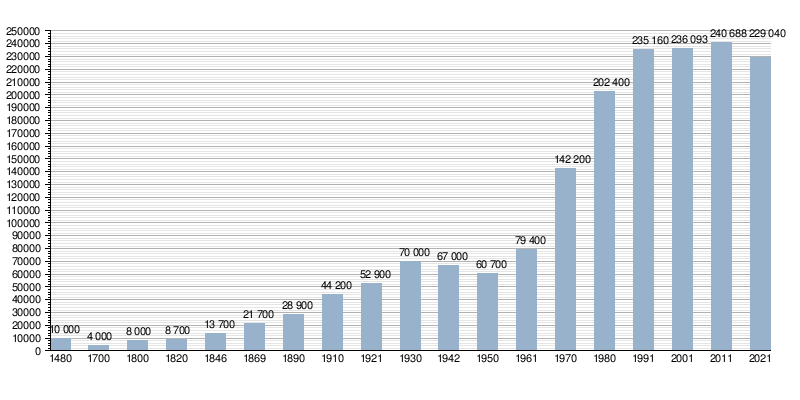
Culture and Arts in Košice
Theaters and Music
Košice has several theaters. The Košice State Theater opened in 1945. It has groups for drama, opera, and ballet. Other theaters include the Marionette Theatre and the Old Town Theatre. Because there are Hungarian and Roma people living here, there are also Hungarian "Thália" and Roma "Romathan" theaters.
Košice is home to the State Philharmonic Košice. This is Slovakia's second professional symphonic orchestra, started in 1968. They put on festivals like the Košice Music Spring Festival.
Museums and Art Galleries
You can find many museums and galleries in Košice. The East Slovak Museum opened in 1872. The Slovak Technical Museum has a planetarium and shows the history of science and technology. The East Slovak Gallery opened in 1951. It collects art from eastern Slovakia.
Košice as a European Capital of Culture
In 2008, Košice won the title of European Capital of Culture for 2013. The goal was to change Košice from a city of heavy industry to a creative city. This project, called "Interface," aimed to bring together business and art. It created new cultural spaces and encouraged creative industries like design, media, and film.
Some of the main places for this project include:
- Kasárne Kulturpark – Old military barracks turned into an art center.
- Kunsthalle Košice – An old swimming pool now used as an art hall.
- SPOTs – Old heat exchangers turned into cultural "spots" in housing areas.
- City park, Park Komenského and Mojzesova – City green spaces that were improved.
Media in Košice
The Golden Beggar is an international festival for local TV broadcasters. It started in 1995 and happens every June in Košice.
The oldest evening newspaper is the Košický večer. The daily paper is Korzár. A newer daily paper is Košice:Dnes (Košice: Today).
TV stations in Košice include TV Naša, TV Region, and the public TV broadcaster RTVS Televízne štúdio Košice.
Radio stations in Košice are Rádio Košice, Dobré rádio, Rádio Kiss, Rádio Šport, and the public broadcaster RTVS Rádio Regina Košice.
Košice's Economy
Košice is the main business center of eastern Slovakia. It produces about 9% of Slovakia's total economic output. The U.S. Steel Košice factory is the biggest employer in the city. It has 13,500 workers.
Another large employer is Deutsche Telekom IT Solutions Slovakia. This company started in Košice in 2006. In 2020, it had 4,545 employees in Košice.
The Košice IT Valley association was created in 2007. It brings together schools, government, and IT companies. It helps the city's technology sector grow. In 2018, it was recognized as a top IT cluster in Central Europe.
Volvo Cars is building a new car factory in Košice. It will open in 2026. Other important industries include engineering, food production, and services. The city's budget was 224 million euros in 2019.
What to See in Košice
The city center has most of the historical sights. They are located on or near Main Street (Hlavná ulica). Košice has the most protected historical buildings in Slovakia.
The most famous building is Slovakia's largest church, the Gothic Cathedral of St. Elizabeth. It was built in the 14th century. It is the easternmost Gothic cathedral in Central Europe. Next to it is the 14th-century St. Michael Chapel. You can also see the St. Urban Tower and the State Theater.
The Executioner's Bastion and the Mill Bastion are parts of the old city walls. The Church of the Virgin Mary's Birth is a beautiful church for Greek Catholics. Other interesting places include the old Town Hall, the Old University, and the Captain's Palace. There are also many galleries like the East Slovak Gallery and museums like the East Slovak Museum.
You can relax in the Municipal Park between the city center and the train station. Košice also has a zoo in the northwest part of the city, in the Kavečany area.
Places to Worship
- Cathedral of St. Elizabeth
- Dominican Church
- Franciscan Church
- Hospital Church of Holy Spirit
- Plague Chapel of St. Rosalie
- Premonstratensian Church, which used to be a Jesuit Church
- Calvinist Church
- Evangelical Church
- Synagogue at Puškinová Street
Learning in Košice: Universities and Schools
Košice is the second-largest university town in Slovakia, after Bratislava. The Technical University of Košice is the biggest, with over 16,000 students. The Pavol Jozef Šafárik University is another major one, with over 7,400 students. Other universities include the University of Veterinary Medicine in Košice and the private Security Management College in Košice.
The city has 38 public elementary schools, six private ones, and three religious schools. There is also an International Baccalaureate (IB) Primary Years Programme (PYP) school. In total, over 20,000 students attend these schools. For older students, there are 20 high schools (gymnasia) and 24 specialized high schools. There are also 13 vocational schools.
Kosice International School (KEIS) is the first international primary school in Eastern Slovakia. It opened in September 2020.
Getting Around Košice
Public transport in Košice is run by the city's Public Transport Company. The city's public transport system is the oldest in Slovakia. The first horse-drawn tram started in 1891 and was made electric in 1914. Today, Košice has buses, trams, and trolleybuses.
The Košice railway station is a major train hub in eastern Slovakia. You can take trains from Košice to cities like Prague, Bratislava, and Miskolc in Hungary. There is also a special wide-gauge track from Ukraine that goes to the steel mill. The D1 motorway connects Košice to Prešov. More motorways are planned around the city.
Košice International Airport is located south of the city. You can fly directly from Košice to places like London, Vienna, Warsaw, Düsseldorf, and Prague.
Sports in Košice
The Košice Peace Marathon started in 1924. It is the oldest annual marathon in Europe and the third oldest in the world. It takes place in the historic part of the city every year on the first Sunday of October.
The Ice hockey club HC Košice is one of Slovakia's most successful hockey teams. They play in the top Slovak league, the Extraliga. They have won many titles, including eight in Slovakia and two in the old Czechoslovak league. Their home arena is the Steel Aréna, which can hold over 8,300 fans.
Košice also hosted the 2011 and 2019 IIHF World Championship for ice hockey, along with Bratislava.
In 2016, Košice was named the European City of Sport. This meant the city hosted many sporting events that year.
Košice's Twin Cities
Košice is twinned with many cities around the world. This means they have special friendly relationships.
 Abaújszántó, Hungary (2007)
Abaújszántó, Hungary (2007) Budapest, Hungary (1997)
Budapest, Hungary (1997) Bursa, Turkey (2000)
Bursa, Turkey (2000) Cottbus, Germany (1992)
Cottbus, Germany (1992) Da Nang, Vietnam (2015)
Da Nang, Vietnam (2015) Ho Chi Minh City, Vietnam (2016)
Ho Chi Minh City, Vietnam (2016) Katowice, Poland (1991)
Katowice, Poland (1991) Krosno, Poland (1991)
Krosno, Poland (1991) Miskolc, Hungary (1997)
Miskolc, Hungary (1997) Mobile, United States (2000)
Mobile, United States (2000) Niš, Serbia (2000)
Niš, Serbia (2000) Ostrava, Czech Republic (2001)
Ostrava, Czech Republic (2001) Plovdiv, Bulgaria (2000)
Plovdiv, Bulgaria (2000) Raahe, Finland (1987)
Raahe, Finland (1987) Rzeszów, Poland (1991)
Rzeszów, Poland (1991) Uzhhorod, Ukraine (1993)
Uzhhorod, Ukraine (1993) Vysoké Tatry, Slovakia (2006)
Vysoké Tatry, Slovakia (2006) Wuhan, China (2012)
Wuhan, China (2012) Wuppertal, Germany (1980)
Wuppertal, Germany (1980)
Former Twin Cities
Because of the 2022 Russian invasion of Ukraine, Košice ended its partnerships with these cities:
 Vitebsk, Belarus (2015)
Vitebsk, Belarus (2015) Saint Petersburg, Russia (1995)
Saint Petersburg, Russia (1995)
Images for kids
See also
 In Spanish: Košice para niños
In Spanish: Košice para niños



